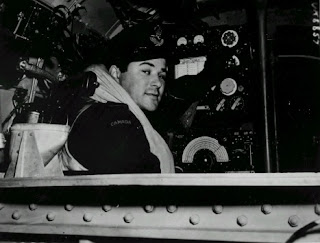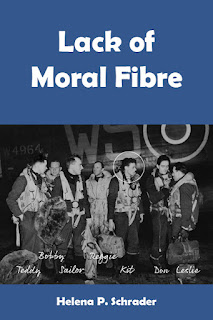It is widely known that seven Americans flew in the Battle
of Britain with RAF Fighter Command and that later several “American Eagle”
squadrons were formed in which all the pilots were Americans. These, however,
were transferred to the USAAF when the United States entered the war and deployed
units to Britain. Less famous are the Americans who flew with Bomber Command, where some individual American pilots successfully resisted the efforts of the USAAF to conscript them and
remained in the RAF. I’d like to tell the story of one of them here: Hubert "Nick" Knilans.
I was unable to locate a photo of Hubert "Nick" Knilans. This picture of a Canadian Lancaster Skipper is used courtesy of the Bomber Command Museum of Canada.
Hubert Knilans was born in Delavan, Wisconsin on 27 December 1917, to an Irish-American farming family. As a Catholic, Knilans grew up knowing that in his home town the white supremacist organization Ku Klux Klan was primarily anti-Catholic, although antisemitism was also prevalent. In the aftermath of the Japanese attack on Pearl Harbor, Knilans hoped that war would unite Americans and put an end to racial and religious discrimination.
In April 1941, Knilans was conscripted into the U.S. army. Knilans already knew he wanted to fly, but in the USAAF he had no chance of being accepted into flight training because he did not have a college degree. Therefore, without a word to his parents, he headed for Detroit, where he arrived utterly broke. With his last dime (figuratively speaking), he bought a bus ticket to Windsor, Canada. His reception by Canadian immigration was telling. He later claimed that they greeted him with the words: “I suppose you’ve come to join the air force?” — and directed him to the RCAF recruiting office nearby. Technically a deserter or draft dodger, Knilans joined the RCAF. He later claimed that he thought he could help “restore happiness to the children of Europe” by destroying Hitler’s regime.
Two years later, after successfully completing initial and advanced flight training, Knilans (along with many colleagues) crossed to the UK by ship in order to start operational training on multi-engine aircraft. Knilans made his trans-Atlantic voyage on the Cunard ocean liner Queen Elizabeth. The former luxury liner was at this time serving as a troop transport, carrying roughly 8000 troops instead of the intended ca 2,300 passengers.
In June 1943, Knilans at last joined an operational squadron, No 619 Lancaster Squadron based at RAF Woodhall Spa in Lincolnshire. From this point forward, he was known in the RAF as "Nick" Knilans, rather than by his given name. His first operational flight as skipper was on the night of July 24/25, flying against Hamburg.
In October, Knilans received word that — despite deserting from the U.S. Army two and half years earlier — he was to be transferred to the USAAF. He refused. Technically, he reported for duty was inducted as a First Lieutenant, and then detached or seconded back to the RAF to complete his tour with 619 Squadron. This was certainly a good arrangement for Knilans as his USAAF First Lieutenant’s pay was roughly the same as the salary of an RAF Group Captain. (Group Captain is the equivalent rank to Colonel in the USAAF.)
In December 1943, Knilan’s Lancaster was attacked by a night fighter on the way to Kassel. His mid-upper and tail gunners were both severely wounded, the rear gunner fatally. In addition, one engine was knocked out and the wings and undercarriage damaged. Nevertheless, Knilans managed to shake off the fighter and continued to the target. For this operation, Knilans was awarded the Distinguished Service Order (DSO). He was later to earn a British Distinguished Flying Cross (DFC), two American DFCs and five American Air Medals. He only wore the DSO on his battle dress, however, because as he explained it:
“I thought it would antagonize others on the same squadron, or confirm their prejudice about bragging Yanks. That was another reason that I did not want a scantily clad girl or a humorous name painted on the aircraft assigned to me. This flying into combat night after night, to me, was not very funny. It was a cold-blooded battle to kill or be killed.” (Source: RAF Museum Website, biography of Knilans.)
By now at the latest, Knilans no longer believed he was either making the children of Europe happy nor helping eliminate racism in America. His father wrote that the local country club remained closed to Jews, while he could see with his own eyes the racism and segregation practiced by the USAAF, even in the UK.
By January 1944, Knilans was also finding it increasingly difficult to engage in the kind of saturation bombing that had become Bomber Command policy. He therefore volunteered for transfer to 617 Squadron. Although 617 had the reputation of a “suicide squadron,” largely due to the exceptionally high casualty rates experienced on a number of its high profile missions, it was also a precision bombing unit. The commanding officers of 617, notably Wing Commander Leonard Cheshire, Wing Commander "Willie" Tait and Group Captain "Johnnie" Fauquier attempted to minimize collateral damage and casualties.
Knilans was not the first American to have flown with 617. At its inception, 617 had included another American flying with Bomber Command, namely Flight Lieutenant Joseph McCarthy. McCarthy had led the flight tasked with breaching the Sorpe Dam during the “Dams Raid” in May 1943. He earned the DSO for his actions on this raid.
In April 1944, Knilans had technically completed his first tour of operations (30 operational flights) but along with his entire crew he volunteered for a second tour with 617. He was one of several pilots tasked with testing the Tallboy bomb, the latest invention of the outstanding British engineer Barnes Wallis. The 12,000 lb Tallboy, when dropped from its optimal altitude of 18,000 feet reached a velocity of 1,100 ft/second on impact — or almost the speed of sound. It could penetrate 15 ft of concrete and triggered a local "earthquake" that made it effective even if the bomb failed to make a direct hit on the target.
On the night of June 5/6, Knilans and other 617 crews contributed to the successful landings in Normandy by dropping aluminum foil to deceive German radar into thinking ships and landing craft were approaching Calais. The aircraft had to fly back-and-forth on a precise course advancing at only eight kilometers per hour to simulate approaching ships.
Following D-Day, 617 Squadron and Knilans returned to operations against strategic targets such as the V-1 and later the V-2 launch pads, submarine and E-boat pens, rail bridges and tunnels used to transport troops and equipment to Wehrmacht units fighting on the Western Front. In one raid, for example, 130 E-boats, which would otherwise have hampered Allied reinforcements to the beachheads in Normandy, were put out of action.
By now, however, Knilans “had the twitch” (in RAF jargon). Increasingly, he had odd sensations in his hands and at times lost his orientation when flying. He described it as “losing his confidence progressively.” We would call it PTSD.
Knilans’ fiftieth — and last — operation was a strike against the German battleship Tirpitz in September 1944. The Tirpitz was faster than any British battleship and armed with 12 anti-aircraft guns, 16 inch-and-a-half, 12 six-inch and 8 fifteen-inch guns, all of which could be fully elevated to shoot at aircraft. The range of her fifteen-inch guns was seventeen miles. Thirty-three attempts had already been made to sink her, and she had survived attacks from torpedo bombers, midget submarines and conventional bombs — which simply bounced off her armor.
Thirty-six aircraft of Nos 617 and 9 squadron made the attempt to sink the Tirpitz in an operation that called for the aircraft to fly first to a Red Air Force base of Yegodnik near Archangel (a twelve-hour flight). From there, after rest and refueling, the aircraft were to attack the Tirpitz from landward. Navigational aids were minimal, and Knilans along with roughly half the other RAF bombers were unable to find Yegodnik before running out of fuel. Knilans managed to put his Lancaster down in a hay field. The next day, however, all four engines cut out shortly after take-off. He restarted the engines by diving but rammed a tall pine tree while recovering from the dive. The tree broke through the nose and shattered the cockpit Perspex. Knilans, nevertheless, safely landed the aircraft at Yegodnik on three engines. Three days later, the repaired aircraft with Knilans at the controls took part in the raid against the Tirpitz, contributing to the debilitating (but not sinking) the battleship. Knilans brought his Lancaster back to Woodhall Spa on September 17, two days after the raid on the Tirpitz. It was one of only 16 of the original 36 aircraft that returned, the rest having been lost in crashes and cannibalization for repair parts rather than enemy action.
Having completed 30 operations with 617 in addition to the 20 he had flown with 619, Knilans “retired” from the RAF. When he stopped flying for the RAF, however, his transfer to the USAAF went into full effect. He was repatriated to the U.S. and employed in the training establishment. He retired from the USAAF at the end of World War Two with the rank of Major.
Knilans vowed that after the war he would do something “constructive,” and chose teaching as the venue for that ambition. He worked as a teacher for 25 years, including two years with the Peace Corps in Nigeria. He was particularly dedicated to helping underprivileged children, particularly Mexican Americans, and also served as a counsellor in California prisons. He retired in 1978 and died in 2012. He never married.
(Sources: RAF Museum Website, John Nichol, Return of the Dambusters: What 617 Squadron Did Next)
I am trying to pay tribute to the men of Bomber Command in my most recent publications. "Lack of Moral Fibre" explores the reason why a decorated flight engineer refuses to fly on a raid to Berlin in late November 1943. The sequel, "Moral Fibre: Story of a Lancaster Skipper," will be released later this year.
My novels about the RAF in WWII are intended as tributes to the men in the air and on the ground that made a victory in Europe against fascism possible.
Lack of Moral Fibre, A Stranger in the Mirror and A Rose in November can be purchased individually in ebook format, or in a collection under the title Grounded Eagles in ebook or paperback. Find out more at: https://crossseaspress.com/grounded-eagles
Where Eagles Never Flew was the the winner of a Hemmingway Award for 20th Century Wartime Fiction and a Maincrest Media Award for Military Fiction. Find out more at: https://crossseaspress.com/where-eagles-never-flew





No comments:
Post a Comment